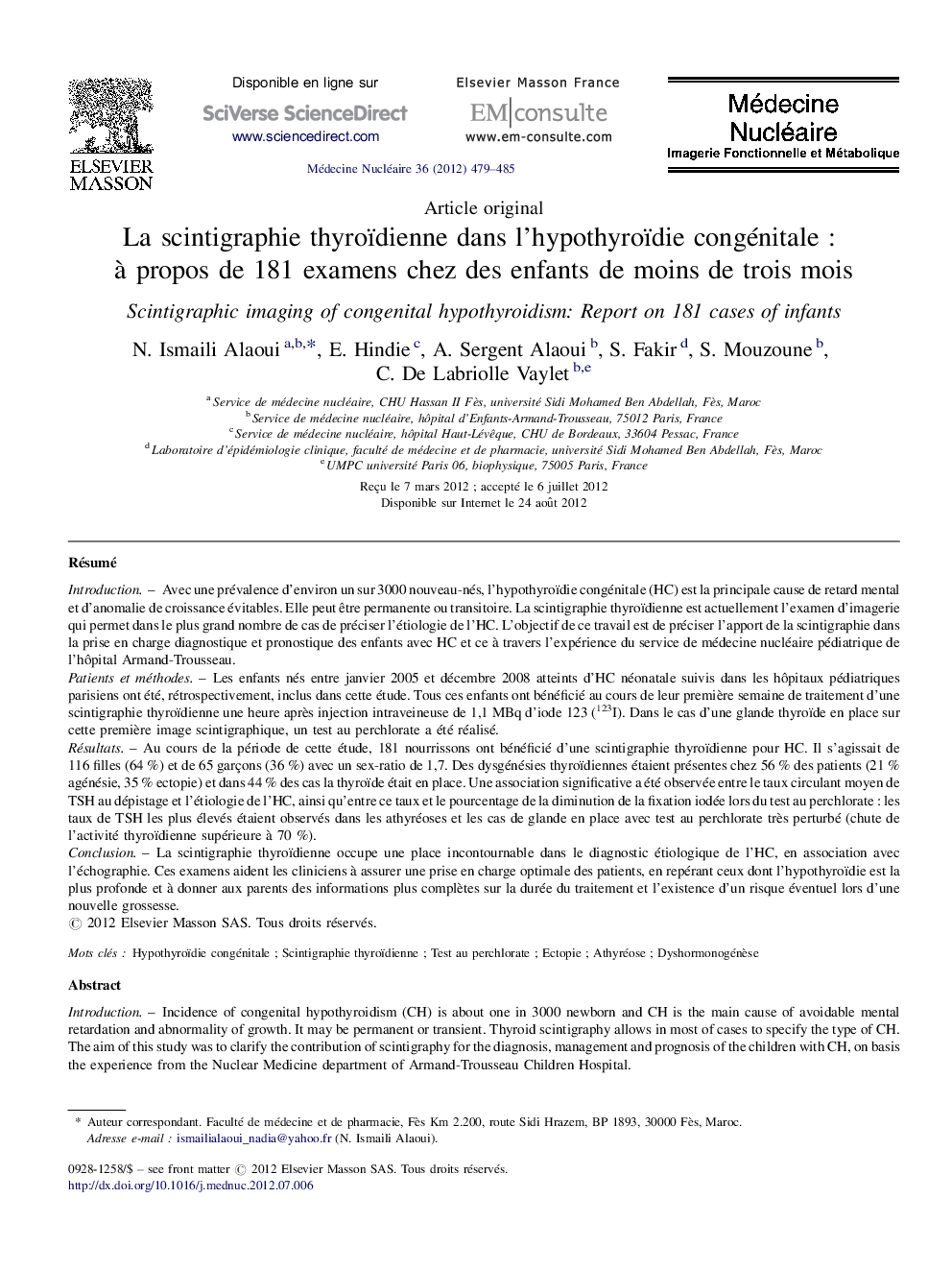| Article ID | Journal | Published Year | Pages | File Type |
|---|---|---|---|---|
| 4243791 | Médecine Nucléaire | 2012 | 7 Pages |
RésuméIntroductionAvec une prévalence d’environ un sur 3000 nouveau-nés, l’hypothyroïdie congénitale (HC) est la principale cause de retard mental et d’anomalie de croissance évitables. Elle peut être permanente ou transitoire. La scintigraphie thyroïdienne est actuellement l’examen d’imagerie qui permet dans le plus grand nombre de cas de préciser l’étiologie de l’HC. L’objectif de ce travail est de préciser l’apport de la scintigraphie dans la prise en charge diagnostique et pronostique des enfants avec HC et ce à travers l’expérience du service de médecine nucléaire pédiatrique de l’hôpital Armand-Trousseau.Patients et méthodesLes enfants nés entre janvier 2005 et décembre 2008 atteints d’HC néonatale suivis dans les hôpitaux pédiatriques parisiens ont été, rétrospectivement, inclus dans cette étude. Tous ces enfants ont bénéficié au cours de leur première semaine de traitement d’une scintigraphie thyroïdienne une heure après injection intraveineuse de 1,1 MBq d’iode 123 (123I). Dans le cas d’une glande thyroïde en place sur cette première image scintigraphique, un test au perchlorate a été réalisé.RésultatsAu cours de la période de cette étude, 181 nourrissons ont bénéficié d’une scintigraphie thyroïdienne pour HC. Il s’agissait de 116 filles (64 %) et de 65 garçons (36 %) avec un sex-ratio de 1,7. Des dysgénésies thyroïdiennes étaient présentes chez 56 % des patients (21 % agénésie, 35 % ectopie) et dans 44 % des cas la thyroïde était en place. Une association significative a été observée entre le taux circulant moyen de TSH au dépistage et l’étiologie de l’HC, ainsi qu’entre ce taux et le pourcentage de la diminution de la fixation iodée lors du test au perchlorate : les taux de TSH les plus élevés étaient observés dans les athyréoses et les cas de glande en place avec test au perchlorate très perturbé (chute de l’activité thyroïdienne supérieure à 70 %).ConclusionLa scintigraphie thyroïdienne occupe une place incontournable dans le diagnostic étiologique de l’HC, en association avec l’échographie. Ces examens aident les cliniciens à assurer une prise en charge optimale des patients, en repérant ceux dont l’hypothyroïdie est la plus profonde et à donner aux parents des informations plus complètes sur la durée du traitement et l’existence d’un risque éventuel lors d’une nouvelle grossesse.
IntroductionIncidence of congenital hypothyroidism (CH) is about one in 3000 newborn and CH is the main cause of avoidable mental retardation and abnormality of growth. It may be permanent or transient. Thyroid scintigraphy allows in most of cases to specify the type of CH. The aim of this study was to clarify the contribution of scintigraphy for the diagnosis, management and prognosis of the children with CH, on basis the experience from the Nuclear Medicine department of Armand-Trousseau Children Hospital.Patients and methodsWe retrospectively reviewed all the children (0–3 months) referred between January 2005 and December 2008 to the pediatric hospitals in Paris for the management of neonatal hypothyroidism. A planar scintigraphic acquisition, including stomach and bladder, was done 1 h after intravenous injection of 1.1 MBq of 123I. When the thyroid was normally located, a perchlorate discharge test was performed.ResultsDuring the study period, 181 infants had thyroid scintigraphy for CH. The sex-ratio girl/boy was 1.7. Fifty-six percent had thyroid dysgenesis (21% agenesis, 35% ectopia). Seventy-nine patients (44%) had an eutopic thyroid. A significant association was observed between TSH levels and etiology of HC, and between TSH levels and the percentage of iodine uptake decrease after the perchlorate discharge test: the highest level of TSH was observed in the case of athyreosis and when perchlorate test was very disturbed (fall of thyroid activity greater than 70%).ConclusionThyroid scintigraphy in association with ultrasound permits a precise characterization of the etiology of CH. These examinations help clinicians to ensure an optimal management of patients by identifying those with most severe hypothyroidism, and to inform parents most completely on duration of treatment and existence of a potential risk during a future pregnancy.
